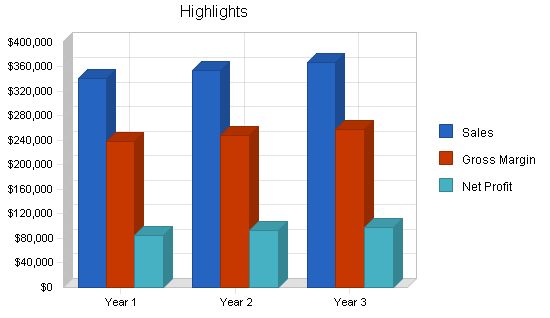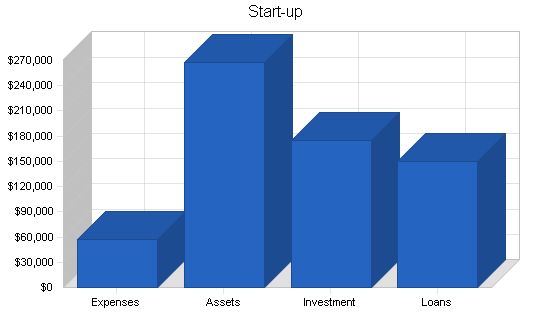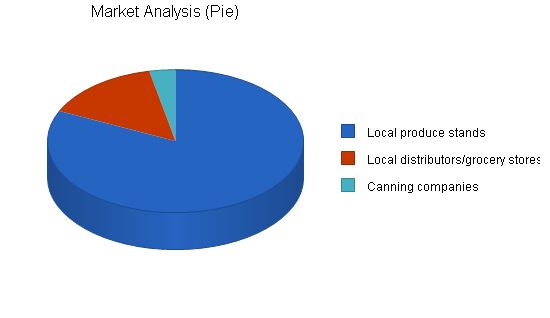Contents
Peach and Apricot Farm Business Plan
Introduction
The Wilson Family Peach Farm is a start-up venture for Dr. Jared Wilson and his wife, Susan. They plan to retire from their regular professions in the spring and use the farm as a source of post-retirement income, while also continuing their research programs on agriculture and nutrition. They will acquire approximately 80 acres of prime stone fruit growing land using owner’s equity and a federal farm assistance loan. The farm will be a jointly owned Limited Liability Company chartered in Georgia.
The Farm and its Products
The farm has prime fruit growing land located approximately 3.5 miles northwest of Gainesville, Georgia. This area is known for its excellent conditions for growing peaches and other stone fruit, including plenty of sunlight, excellent drainage, and optimal soil pH.
The Wilson Family Peach Farm plans to grow seven varieties of peaches and nectarines in the first three years, including Redhaven, Ishtara, Tenn Natural, Lovell, Bailey, Montclar, Starks Redleaf, and the famous Elberta. Once profitability is established, the farm will expand into more rare varieties.
Fresh, high-quality peaches and nectarines are attractive because they are sweet tasting and low in calories. One medium peach contains only about 37 calories and is a good source of Vitamin C, while yellow-fleshed varieties are a good source of Vitamin A.
The Market
The United States supplies about one-fourth (25%) of the world’s total fresh peaches.
Peaches are the third most popular fruit in America, accounting for over 70% of all stone fruit produced in the country. South Carolina and Georgia follow California’s 72% share of peach production, with around 6% and 4% of the U.S. total over the past three years. Last year, Georgia produced 115 million pounds of peaches worth $41.7 million. Georgia now grows more than 40 commercial varieties of peaches and there is potential for expansion in the international market, particularly in Asia.
Wilson Family Peach Farm plans to sell its crop to three main buyers. They will focus on selling the majority of their fruit to local produce stands that can charge higher prices for higher quality fruit. The remaining fruit will be sold to local fruit packers and distributors, who in turn resell the fruit to grocery stores. Any fruit that does not meet the quality/maturity standards of the other buyers will be sold to canneries.
Financial Considerations
The farm will be financed with a farm assistance loan and owner’s equity. This will provide sufficient cash flow until the farm can generate revenue. Sales are projected to be profitable in the first year and experience consistent growth through year three.

1.1 Objectives
The objectives for the Wilson Family Peach Farm over the next three years are:
- Achieve profitability in year one.
- Expand by purchasing an additional 50 acres of adjacent land by year three.
- Capitalize on the niche market for hybrid and specialty stone fruits.
- Increase yield per acre to achieve economies of scale.
1.2 Mission
The mission of the Wilson Family Peach Farm is to provide a retirement occupation and supplemental income for the owners, Jared and Susan Wilson. Additionally, the farm will serve as a base for Dr. and Mrs. Wilson’s ongoing research in agriculture and nutrition.
1.3 Keys to Success
Farming in the United States is a mature industry with little growth and a competitive market. Therefore, the Wilsons will focus on the small niche market of hybrid and rare peaches, nectarines, and other stone fruit, while emphasizing quality to maintain supplier contracts with chain distributors and local produce sellers. The Wilsons have identified the following key elements to success:
- Become "first to market" through early harvest varieties of peaches and nectarines.
- Focus on marketing hybrids to local distributors.
- Aggressively pursue cost analysis and reduction.
- Concentrate on post-harvest care of produce to enhance quality.
- Target high-end local produce stands that can demand higher prices.
- Capitalize on Dr. Jared Wilson’s close contacts with the University of Georgia’s Agriculture department faculty to introduce new scientific methods and procedures to growing stone fruit.
Company Summary
The Wilson Family Peach Farm is a start-up venture for Dr. Jared Wilson and his wife, Susan. They will be retiring from their regular professions starting in spring of this year. The farm will provide the Wilsons with an opportunity for post-retirement work and income, as well as a platform for their individual research programs on agriculture and nutrition. They plan to acquire approximately 80 acres of prime stone fruit growing land, with 60 acres being bought outright using owner’s equity and a federal farm assistance loan. The remaining 20 acres will be rented. All farmland will be centrally located. The farm will be jointly owned by Dr. and Mrs. Wilson and will be set up as a Limited Liability Company chartered in Georgia.
2.1 Start-up Summary
Farming is a capital intensive industry that requires significant investment in long-term assets such as land and farm equipment. Additionally, farming is highly seasonal, with profits generated only during a few months of the year while expenses are spread out over the entire twelve months. Therefore, having a substantial amount of cash and cash equivalent assets at the start is necessary. The farm will be financed with a farm assistance loan and a significant amount of owner’s equity, providing sufficient cash flow until it can start generating a profit.

Start-up Expenses to Fund: $57,000
Start-up Assets to Fund: $268,000
Total Funding Required: $325,000
Assets:
Non-cash Assets from Start-up: $140,280
Cash Requirements from Start-up: $127,720
Additional Cash Raised: $0
Cash Balance on Starting Date: $127,720
Total Assets: $268,000
Liabilities and Capital:
Liabilities:
Current Borrowing: $25,000
Long-term Liabilities: $100,000
Accounts Payable (Outstanding Bills): $0
Other Current Liabilities (interest-free): $25,000
Total Liabilities: $150,000
Capital:
Planned Investment:
Dr. and Mrs. Wilson: $175,000
Other: $0
Additional Investment Requirement: $0
Total Planned Investment: $175,000
Loss at Start-up (Start-up Expenses): ($57,000)
Total Capital: $118,000
Total Capital and Liabilities: $268,000
Total Funding: $325,000
Start-up Requirements:
Start-up Expenses:
Legal: $2,000
Repairs to facilities/equipment: $15,000
Insurance: $5,000
Rent: $5,000
Research and development: $5,000
Expensed equipment: $20,000
Herbicides/pesticides: $5,000
Total Start-up Expenses: $57,000
Start-up Assets:
Cash Required: $127,720
Start-up Inventory: $0
Other Current Assets: $0
Long-term Assets: $140,280
Total Assets: $268,000
Total Requirements: $325,000
Company Locations and Facilities:
The Wilsons have made the down payment/rent on 80 acres of prime fruit growing land approximately 3.5 northwest of Gainesville, Georgia. This is one of the best areas in the state for growing peaches and other stone fruit. The acreage being sought has been a successful peach farm in the past and gets plenty of sunlight, especially early morning sunlight that dries the dew from the trees, thereby reducing the incidence of diseases. The area also has excellent drainage and an optimum soil pH of around 6.0.
The farm comes with a century-old house, in good condition, barn and storage area, including large refrigeration facilities, and excellent irrigation equipment. Georgia has two commercial peach-growing regions. The central region is the largest with about 70 percent of the peach trees and 83 percent of the state’s production. The northeastern region has about 23 percent of the trees and produces 17 percent of the state’s harvest. The location of the farm is ideal as it straddles both regions.
Products:
The Wilson Family Peach Farm plans to grow seven varieties of peaches and nectarines in the first three years, including Redhaven, Ishtara, Tenn Natural, Lovell, Bailey, Montclar, Starks Redleaf, and the famous Elberta. Once profitability has been established, the farm will begin to expand into more rare varieties such as the new Guardian, which is well suited to the local environment. In addition, the farm will dedicate approximately ten acres to the growing of hybrids such as pluots, a combination of apricots and plums. Trees will be spaced 16 ft apart within rows 20 ft apart. Average yield per tree is expected to be 132 lbs/tree, with anticipated increases to as much as 160 lbs/tree due to prime area and proprietary methods. Expected yields per acre will be around 500 bushels.
Marketing will target local produce stands that concentrate on hybrids and offer higher margins for high-quality fruits. In addition, Mrs. Wilson has established contracts with distributors to local grocery stores. Any damaged fruit that is still edible will be sold to canning factories.
Product Description:
Peaches are grown on fruit trees (Prunus persica) of the family Rosaceae (rose family) with decorative pink blossoms and a juicy, sweet fruit. Several horticultural varieties were brought to North America by the Spanish and have become naturalized. The numerous varieties of peaches under cultivation are generally distinguished as clingstone or freestone, with the latter including the famous Elberta peach. In the United States, commercial peach production centers in California and the southern Atlantic states. The peach is closely related to other species of Prunus, such as cherry, plum, and almond.
The nectarine is a smooth-skinned peach with both freestone and clingstone varieties. It is a classical example of bud variation. The nectarine tree occasionally produces peaches, and the peach tree nectarines. In appearance, culture, and care, the nectarine is almost identical to the peach.
Peaches and nectarines are sweet tasting and low in calories, with one medium peach containing about 37 calories. They are a good source of Vitamin C and yellow-fleshed varieties are a good source of Vitamin A.
Peach/nectarine harvest begins in May, peaks in July, and ends in August.
One of the most critical aspects of fruit farming is post-harvest treatment, which can preserve or destroy its freshness and appeal. Peaches have a post-harvest life of 14-28 days if handled properly. Dr. Wilson’s research focused on the post-harvest treatment of stone fruit. Efforts will be made to create the best environment for the preservation of the harvest, including monitoring the fruit’s maturity and quality indices, optimizing storage temperature and relative humidity, and regulating respiration and ethylene production.
Sourcing:
Site and Soil Requirements:
Sunlight is crucial for maximizing fruit production. The planting site needs to be in the sun most or all of the day, with the early morning sun being particularly important. The site should have good drainage and a deep soil ranging in texture from sandy loam to sandy clay loam. Peach trees are extremely sensitive to poorly drained soils.
Most fruit plants, including peaches, grow best when the soil pH is near 6.5. Lime should be incorporated before planting to raise the pH to the desired level.
Purchasing Trees:
When buying peach trees, it is important to consider quality. Bargain plants are often unhealthy or not suitable for the area. The Wilsons have a reliable source of trees, rootstocks, and saplings.
Trees should meet the following criteria:
– A healthy one-year-old tree, approximately three to four feet tall
– A good root system
– Trees no older than two years with sufficient buds on the lower portion of the trunk
– No stunted, poorly grown, diseased, or insect-injured trees
Fertilization:
Fertilizing peaches starts with adjusting the soil pH to 6.5 before planting. Additional fertilization using lime and calcium nitrate will occur in March and August.
Distribution:
Selling fruit to local produce stands allows for higher margins, as these stands focus on high-quality produce and rare cultivars. The Wilsons have established contracts with ten different local produce sellers and a local distributor. Final approval of these contracts will depend on the quality of the farm’s produce.
Competitive Comparison:
The peach farming industry is highly competitive, with high capital costs, low margins, and intense competition. The produce is seen as undifferentiated, resulting in high buyer power. Entry and exit barriers are moderately high. The advantage of producing at high volume and benefiting from economies of scale is attractive. Differentiation can be achieved by serving a niche market or adopting a low-cost leadership approach.
Technology:
Dr. Wilson’s research has focused on technological and biological developments in the stone fruit growing field. He intends to continue introducing new procedures and processes to maintain a competitive advantage. The farm will utilize the new laser puff to measure the ripeness of peaches, developed by University of Georgia engineers.
Future Products:
Once profitability is established, the farm plans to grow newer varieties such as the Guardian, as well as hybrids for the specialty fruit market to achieve higher margins.
Market Analysis Summary:
The United States provides about one-fourth (25%) of the world’s total supply of fresh peaches. Peaches are the third most popular fruit grown in America, accounting for over 70 percent of all stone fruit produced in the U.S. Georgia follows California in peach production, with more than 40 commercial varieties.
The Wilson Family Peach Farm plans to sell its crop to three main buyers: local produce stands, fruit packers and distributors, and canneries.
Overall, the provided text has been reviewed and streamlined to eliminate redundancies and improve readability without losing the original meaning or tone.

Market Analysis
Potential Customers Growth Year 1 Year 2 Year 3 Year 4 Year 5 CAGR
Local produce stands 1% 100 101 102 103 104 0.99%
Local distributors/grocery stores 1% 18 18 18 18 18 0.00%
Canning companies 1% 4 4 4 4 4 0.00%
Total 0.81% 122 123 124 125 126 0.81%
Hello!
I’m Andrew Brooks, a seasoned finance consultant from the USA and the mind behind phonenumber247.com.
My career is built on a foundation of helping individuals and businesses thrive financially in an ever-changing economic landscape. At phonenumber247.com, my aim is to demystify the complex world of finance, providing clear, actionable advice that can help you navigate your financial journey with confidence. Whether it’s personal finance management, investment strategies, or understanding the nuances of market dynamics, I’m here to share insights and tools that can propel you towards your financial goals.
Welcome to my digital space, where every piece of advice is a step closer to financial clarity and success!
